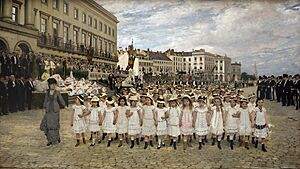Paul Saintenoy facts for kids
Quick facts for kids
Paul Saintenoy
|
|
|---|---|
| Born |
Paul Saintenoy
19 June 1862 Ixelles, Belgium
|
| Died | 18 July 1952 (aged 90) Ixelles, Belgium
|
| Alma mater | Royal Academy of Fine Arts |
| Occupation | Architect |
| Awards | Order of Leopold (1932) |
| Buildings | Brussels-North railway station, Old England |
Paul Saintenoy (born June 19, 1862 – died July 18, 1952) was a Belgian architect. He was also a teacher, someone who studied the history of buildings, and a writer.
Contents
Paul's Family and Early Life
Paul Saintenoy was born in 1862 in Ixelles, a town near Brussels, Belgium. His father, Gustave Saintenoy, was also an architect. His grandfather, Jean-Pierre Cluysenaar, was a very famous architect too.
The Saintenoy family lived in a special house in Brussels called the Hôtel Saintenoy. This house became a protected historic building in 1992.
Becoming an Architect
In 1881, Paul Saintenoy began studying architecture. He went to the Royal Academy of Fine Arts in Antwerp. There, he learned from an architect named Joseph Schadde.
While studying, Paul became very interested in archaeology. This is the study of old things and places. He also learned about restoring old buildings from the Middle Ages. His teacher, Joseph Schadde, was also involved in this kind of work.
Paul later returned to Brussels to finish his training. In the 1890s, he was greatly inspired by other architects. These included Victor Horta and Paul Hankar. He also liked the ideas of Eugène Viollet-le-Duc, who was famous for fixing Gothic buildings.
Horta and Hankar helped start a new style of building called Art Nouveau in Belgium and France. This style used new building methods. It often had steel frames and large glass windows. This made buildings bright inside and connected them more to the outside. This was great for shops and department stores, making it fun to look at window displays.
Paul's Work and Teaching
Paul Saintenoy was not as famous as some other Art Nouveau architects. But he was well-known for his many buildings in this style. Many of his smaller houses in Brussels still stand today. They are an important part of the city's history.
Because of his interest in archaeology, Paul became a teacher. In 1910, he started teaching the history of architecture. He taught at the Académie Royale des Beaux-Arts in Brussels for about 30 years.
After World War I, Paul Saintenoy helped rebuild Belgium. He was part of the Royal Commission of Monuments and Sites. This group helped fix buildings damaged during the war.
Paul's own house in Brussels became a protected historic building in 1992. His son, Jacques Saintenoy (1895–1947), also became an architect.
Paul's Personal Life
Paul Saintenoy married Louise Ponselet. Louise was the niece of a painter named Jan Verhas. Louise appeared in several of her uncle's paintings when she was little.
Paul and Louise had two children:
- Jacques Saintenoy (1895–1947), who became an architect.
- Jacqueline Saintenoy (1900–1978), who married a French minister.
Paul Saintenoy passed away in 1952. He was buried in Ixelles Cemetery. His son Jacques was buried in the same grave in 1947.
Recognitions
Paul Saintenoy received several honors for his work:
- In 1932, he was made a Commander of the Order of Leopold. This is a high honor in Belgium.
- He was also a member of the Royal Academy of Science, Letters and Fine Arts of Belgium.
Important Buildings by Paul Saintenoy
Paul Saintenoy designed or renovated many notable buildings. Here are some of his works:
- Renovation of the Hôtel Ravenstein, Brussels (1894)
- Renovation of the Hôtel Saintenoy (his own house), Ixelles-Elsene (1897)
- Palace of the city Brussels (Brussels International Exposition), Brussels (1897)
- Old England Department Store, Brussels (1898–99)
- Former Delacre Pharmacy, Brussels (1898)
- Hôtel Baron Lunden, Brussels (1898)
- Maison Losseau, Mons (1899)
- House of J. Van Ophem, Brussels (1900)
- Château Le Fy, Esneux (1904–05)
- Brussels-North railway station: clock tower and ticket hall (1952–1956)
Images for kids
-
The Clock tower of Brussels-North railway station (1952–1956).







